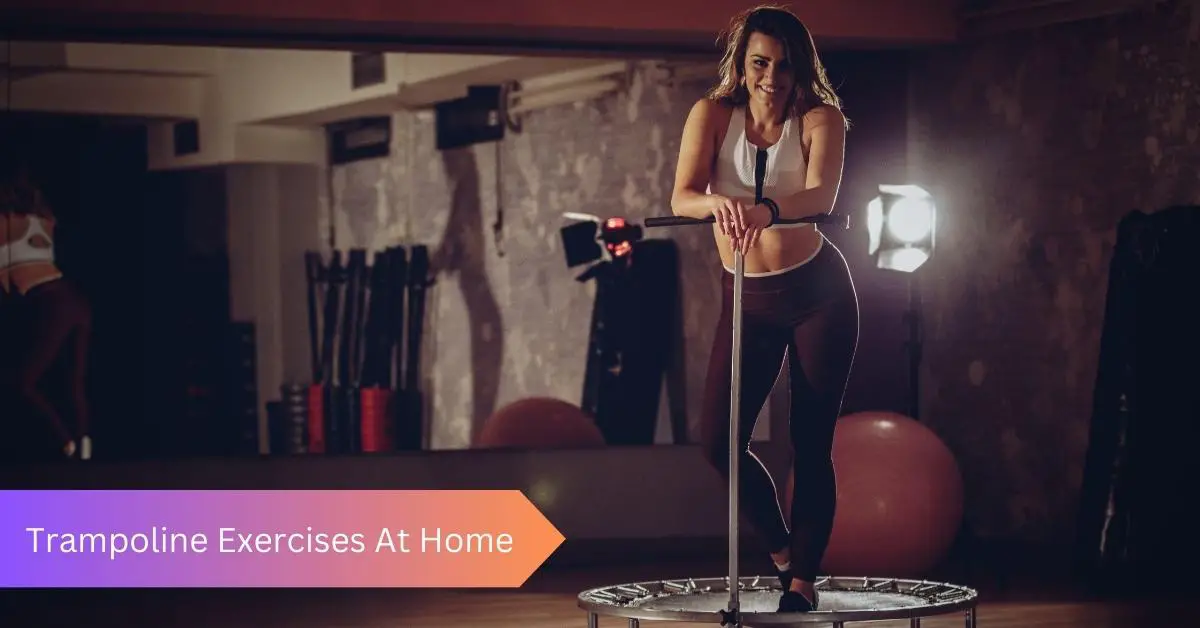Supercharge your workouts with trampoline exercises at home! Bounce your way to a fitter while having fun. Click now for the ultimate fitness experience!”
Looking for a fun and effective way to stay fit and active from the comfort of your own home? Look no further than trampoline exercises!
Trampolines offer a low-impact, high-intensity workout that can help you improve cardiovascular fitness, build strength, work your core muscles, and increase flexibility.
In this article, we will guide you through a variety of trampoline exercises that you can easily do at home. From warm-up exercises to get your body ready for the workout to cardiovascular exercises that get your heart pumping, strength training exercises to tone and build muscle, core exercises to strengthen your abs and back, stretching exercises to improve flexibility, and even some fun and creative workout ideas to keep things interesting.
But before we dive into the different types of trampoline exercises, it’s crucial to prioritize safety. We will provide you with some essential safety tips and tips on maintaining your trampoline correctly.
So get ready to bounce your way to better fitness with these trampoline exercises! Let’s jump in!
Trampoline Exercises At Home: Trampoline exercises at home offer a fun and effective way to stay fit. Bounce to improved cardiovascular health, increased coordination, and strengthened muscles. With a tiny trampoline, you can enjoy low-impact workouts that energize your body and mind. Jump into fitness at home
Benefits of Trampoline Exercises At Home
You’ll love how trampoline exercises can benefit your overall health and fitness! Not only are they a fun way to stay active, but they also provide numerous benefits for your body.
One of the key advantages of trampoline exercises is that they help improve balance. When you jump on a trampoline, your body constantly works to maintain stability, strengthening the muscles responsible for balance. This can be especially beneficial for older adults at risk of falls.
In addition to improving balance, trampoline exercises also help increase stamina. Jumping on a trampoline requires constant movement and engagement of various muscle groups, which helps build endurance over time.
By incorporating trampoline exercises into your routine, you can gradually increase the duration and intensity of your workouts, leading to improved stamina and cardiovascular fitness.
Another advantage of trampoline exercises is their low-impact nature. Unlike running or jumping on hard surfaces, jumping on a trampoline puts less stress on your joints and bones. This makes it an ideal exercise option for individuals with joint pain or those recovering from injuries.
Trampoline exercises offer a range of benefits, including improved balance, increased stamina, and low-impact workout options. So why not give it a try? Start bouncing today and enjoy the many advantages of this fun form of exercise!
Warm-Up Exercises

To get your body ready for a trampoline workout, it’s essential to start with some warm-up exercises. A proper warm-up routine is crucial to prevent injuries and maximize the benefits of your trampoline exercises.
One effective way to warm up is through dynamic stretching. This involves moving your joints and muscles through their full range of motion in a controlled manner.
Start by performing some light cardio exercises such as jogging or jumping jacks for about 5 minutes. This will increase your heart rate and blood flow, preparing your body for the upcoming workout.
After that, focus on dynamic stretches that target the major muscle groups used during trampoline exercises. For example, you can do leg swings to loosen up your hips and legs, arm circles to mobilize your shoulders, and torso twists to engage your core.
Incorporating these dynamic stretches into your warm-up routine will improve flexibility, enhance coordination, and reduce the risk of injury.
Remember to listen to your body and adjust the intensity of the warm-up based on your fitness level. It’s always better to start slowly and gradually increase the power rather than pushing yourself too hard from the beginning.
Following a proper warm-up routine that includes dynamic stretching can prepare your body for a safe and effective trampoline workout at home.
Cardiovascular Exercises
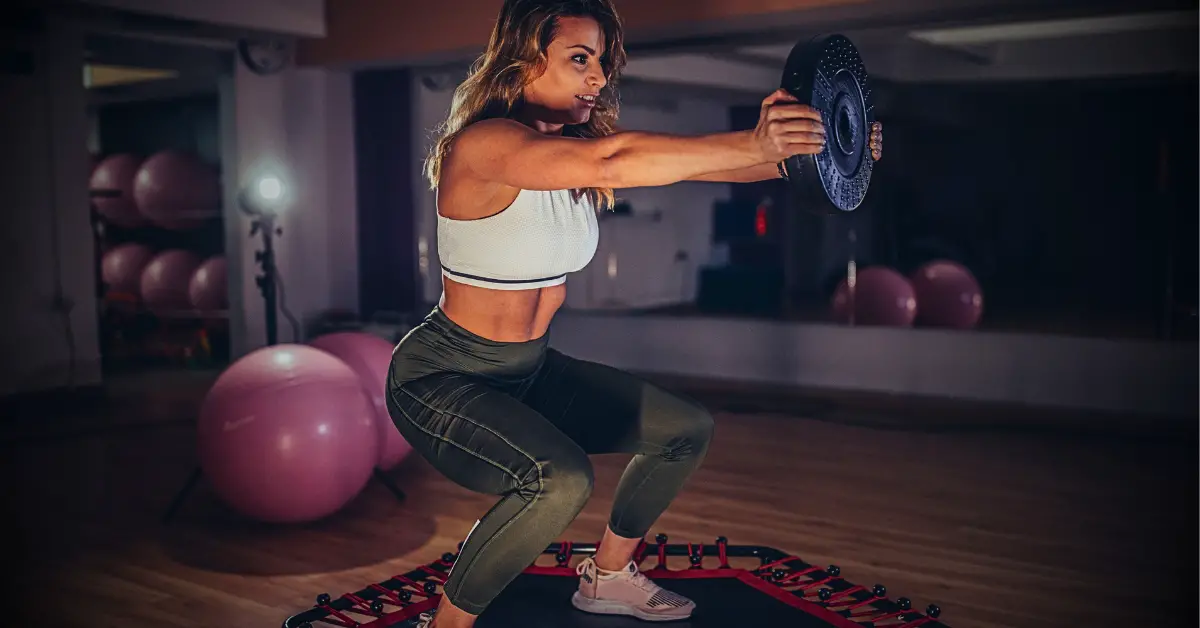
Engage in energetic activities that stimulate your heart and improve your cardiovascular fitness. One great way to achieve this is by incorporating jumping jacks variations into your trampoline workout routine.
Jumping jacks are a classic exercise that not only elevates your heart rate but also engages multiple muscle groups throughout your body. To add variety, you can try different variations of jumping jacks on the trampoline, such as wide-legged or cross-jack jumps.
Another effective cardiovascular exercise you can do on the trampoline is high-intensity interval training (HIIT). HIIT involves alternating between short bursts of intense activity and brief recovery periods. This type of workout effectively improves cardiovascular fitness and burns calories.
To incorporate HIIT into your trampoline workout, start with a warm-up period of light bouncing. Then, increase the intensity by performing exercises like high knees or tuck jumps for 30 seconds, followed by a 15-second rest period.
Repeat this cycle for several rounds to challenge yourself and maximize the cardiovascular benefits.
Always listen to your body and start at an appropriate intensity level. As you build endurance and strength, gradually increase the duration and intensity of your cardio exercises on the trampoline.
Regularly engaging in these energetic activities will improve your cardiovascular fitness and bring you closer to achieving your overall health goals.
Strength Training Exercises
Incorporate various exercises into your routine to strengthen your muscles and improve your overall strength. Squats are great for targeting your lower body muscles, while lunges work the glutes and thighs.
Push-ups engage multiple muscle groups in the upper body, while planks help build core strength. Lastly, mountain climbers provide a full-body workout that also increases cardiovascular endurance.
Include these exercises in your strength training program to see improvements in both muscle tone and overall fitness level.
Squats
Feel the burn in your thighs and glutes as you power through squats on your trampoline at home. Squats are a fantastic exercise for building strength in your lower body, and doing them on a trampoline adds an extra element of challenge and fun.
To perform a squat on your trampoline, stand with your feet shoulder-width apart, then lower yourself down as if sitting back into an imaginary chair. Keep your weight in your heels and engage your core as you push back up to the starting position.
Try incorporating lunges or push-ups into your trampoline workout routine for added variety. Lunges target the muscles in your legs and hips, while push-ups work out your chest, arms, and shoulders.
Combining these exercises on the trampoline can effectively strengthen multiple muscle groups while enjoying a dynamic and engaging workout experience.
| Exercise | Muscles Targeted |
|---|---|
| Squats | Thighs & Glutes |
| Lunges | Legs & Hips |
| Push-ups | Chest, Arms & Shoulders |
Always warm up before starting any exercise routine and listen to your body to avoid injury. Happy bouncing!
Lunges
Now that you’ve mastered squats, let’s move on to lunges.
Lunges are a fantastic exercise that targets your glutes, quads, and hamstrings while improving your balance and stability.
You can try several variations of lunges to keep your workouts exciting and challenging.
One popular variation is the forward lunge, where you step forward with one foot and lower your body until both knees are bent at a 90-degree angle.
Another variation is the reverse lunge, where you step back with one foot instead of forward. It’s essential to maintain proper lunge form throughout each repetition.
Keep your chest lifted, shoulders back, and core engaged. Keep the knee of your front leg aligned with your ankle and avoid letting it extend past your toes.
By incorporating lunges into your trampoline exercises at home routine, you’ll continue strengthening and toning your lower body while enjoying a fun workout experience.
Push-Ups

You can challenge yourself and build upper body strength by incorporating push-ups into your routine. Push-ups on a trampoline provide an added challenge as the unstable surface engages more muscles in your core and stabilizer muscles.
To perform trampoline push-ups, start in a plank position with your hands on the trampoline and slightly wider than shoulder-width apart.
Lower your chest towards the trampoline, keeping your elbows close to your body. Push back up to the starting position, focusing on engaging your chest, shoulders, and triceps.
Remember to maintain proper form throughout the exercise by keeping a straight line from head to heels and avoiding sagging or raising of the hips.
By adding these trampoline variations to your workout routine, you will not only strengthen your upper body but also improve balance and stability.
Plank
Challenge yourself and strengthen your core by incorporating the plank into your routine. Plank variations offer a range of exercises that target different muscle groups while engaging your entire body.
Start with the basic plank, where you support your body on your forearms and toes, keeping a straight line from head to toe. Try side or elevated planks by resting on one forearm or using an exercise ball under your feet to intensify the workout.
The plank is great for building core strength and helps improve balance and stability. Holding the position for longer can enhance endurance and strengthen abdominal muscles.
Add plank variations to your trampoline exercises at home for increased effectiveness and overall fitness benefits.
Mountain Climbers
Get ready to feel the burn with mountain climbers, an intense exercise that targets multiple muscle groups while providing a cardiovascular challenge. Mountain climbers are a dynamic movement that mimics the motion of climbing a mountain, engaging your core, shoulders, arms, and legs.
This exercise is great for building endurance and increasing strength in these areas. To perform mountain climbers, start in a high plank position with your hands directly under your shoulders and your body in a straight line.
From there, alternate bringing one knee towards your chest while extending the other leg behind you. Continue this alternating motion quickly for the desired number of reps or time.
Here are some modifications you can try to tailor mountain climbers to your fitness level:
| Modification | How To Perform |
|---|---|
| Knee Taps | Instead of fully extending your leg behind you, tap your knee down lightly on each side. |
| Slow Tempo | Slow down the pace of the movement to focus on control and stability. |
| Elevated Surface | Place your hands on an elevated surface such as a step or bench to reduce the range of motion. |
Mountain climbers offer numerous benefits, including improved cardiovascular health, increased core strength and stability, enhanced coordination and agility, as well as calorie-burning potential. Incorporating this exercise into your trampoline workout routine will surely elevate both intensity and results!
Core Exercises
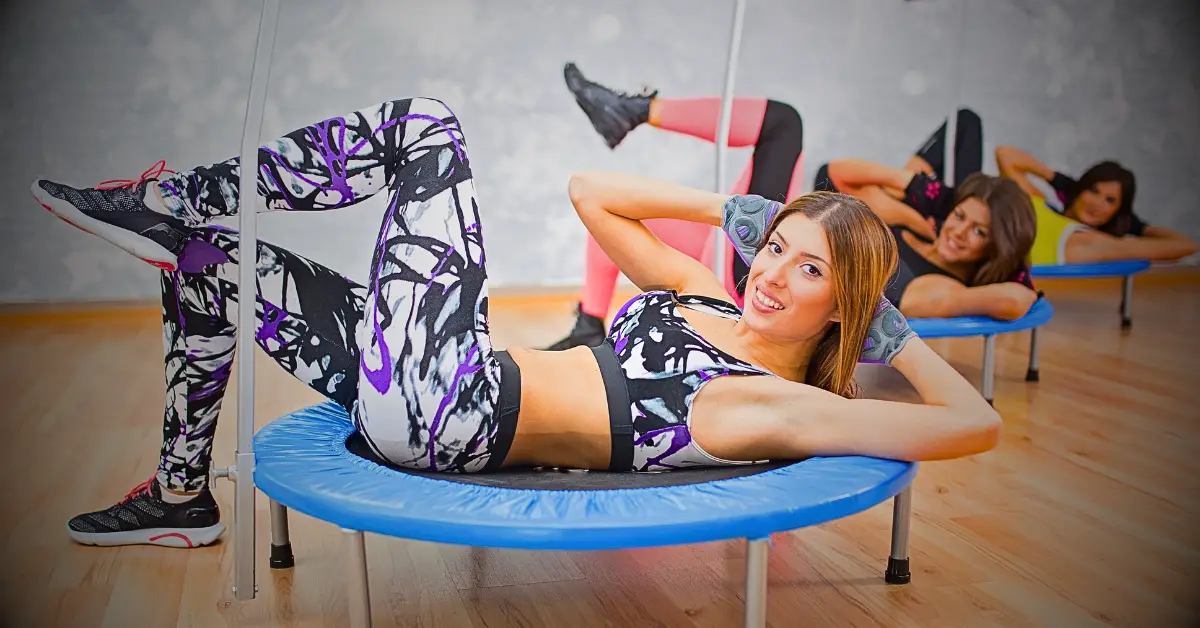
Liven up your core workout routine with these practical trampoline exercises you can do at home. Core stability is crucial for maintaining good posture and preventing injuries.
By incorporating trampoline exercises into your routine, you can engage your core muscles in a fun and dynamic way.
One great trampoline exercise for core stability is the tuck jump. Start by standing on the trampoline with your feet hip-width apart. Bend your knees and jump up, bringing them towards your chest as you reach the peak of your jump. Land softly back on the trampoline and repeat for a set number of repetitions.
Another effective exercise is the plank bounce. Begin by getting into a plank position on the trampoline, resting your forearms on its surface. Engage your core muscles to maintain a straight line from head to toe. Then, gently bounce up and down while keeping proper form.
In addition to these exercises, there are various abdominal exercises that you can perform on a trampoline to strengthen your core. These include knee tucks, Russian twists, and bicycle crunches.
Incorporating these trampoline exercises into your workout routine will help improve core stability and strengthen your abdominal muscles. Always warm up before exercising and listen to your body’s limits to prevent injuries or strain.
Balance and Coordination Exercises
Balance and coordination are essential for overall fitness and can be achieved through engaging activities. Trampoline exercises provide an excellent opportunity to challenge your balance and enhance your coordination skills.
By incorporating specific balance challenges and coordination drills into your trampoline workouts, you can improve these essential aspects of fitness while having fun at home.
Try standing on one leg while bouncing lightly on the trampoline to work on your balance. This exercise will require you to engage your core muscles to maintain stability. You can also experiment with different positions, such as squatting or kneeling while bouncing, which will further challenge your balance.
For coordination drills, focus on performing various movements that require precise timing and control. Jumping jacks, high knees, or even simple toe taps are great exercises to enhance coordination on the trampoline.
As you become more comfortable with these movements, try combining them in sequences to create a challenging routine.
Remember to start slowly and gradually increasing your trampoline exercises’ intensity as you build strength and confidence in your balance and coordination abilities. Always prioritize safety by ensuring proper form and using a well-maintained trampoline.
With consistent practice, you’ll see significant improvements in both your balance and coordination skills, leading to enhanced overall fitness levels.
Rock Your Core
Lie down on your back with your knees bent and feet flat on the floor. Put your hands on the lower part of your back, with your fingers pointing towards your tailbone.
Now, breathe out and lift your shoulders off the ground, keeping your arms straight, while also lifting your hips a bit. Hold this position for a moment, and then breathe in as you lower yourself back down. Do this movement ten times in a row.
Stretching Exercises
Incorporating stretching exercises into your routine improves your flexibility and prevents muscle imbalances.
Focus on key areas such as the hamstrings, quads, calves, shoulders, and chest.
Regularly performing hamstring, quad, calf, shoulder, and chest stretches can enhance your overall range of motion and reduce the risk of injuries during physical activity.
Hamstring Stretch
Stretching your hamstrings is essential for increasing flexibility and preventing injury. To improve hamstring flexibility, start by standing with your feet hip-width apart. Step one foot forward and slightly bend the knee, keeping the other leg straight.
Slowly lean forward from your hips, reaching towards your toes while maintaining a flat back. Hold this stretch for 30 seconds and then switch sides.
Another effective exercise is the seated hamstring stretch. Sit on the edge of a sturdy chair or bench with one leg extended in front of you and the other bent at a 90-degree angle.
Lean forward from your hips, reaching towards your toes while keeping your back straight. Hold for 30 seconds before switching legs.
Regularly incorporating these stretches into your trampoline exercises will help improve hamstring flexibility and reduce the risk of injury.
Quad Stretch
Feel the burn in your quads as you lean back and grab onto your foot, pulling it towards your glutes for a deep quad stretch. Take advantage of the trampoline’s stability to enhance this exercise while ensuring safety.
Before attempting stretches on the trampoline, ensure it is appropriately set up and secure. To perform the quad stretch, follow these steps:
- Stand upright on the trampoline with feet hip-width apart.
- Bend one leg at the knee, bringing your foot towards your glutes.
- Reach back with the same-side hand and grab onto your foot.
- Pull your foot closer to your glutes until you feel a stretch in your quadriceps.
- Hold this position for 20-30 seconds, then release and switch sides.
Remember to maintain proper form throughout the exercise and listen to your body’s limits to prevent injury. Incorporate this quad stretch into your trampoline routine for increased flexibility and muscle strength.
Calf Stretch
Great job on the quad stretch! Let’s move on to the next exercise: the calf stretch. This exercise is crucial for calf strengthening and improving ankle flexibility. It targets your calves, vital in stabilizing your ankles during various physical activities.
To perform a calf stretch, stand facing a wall with one foot slightly behind the other. Place your hands on the wall at shoulder level for support. Keep your back leg straight and press your heel into the ground while bending your front knee. You should feel a gentle stretch in your calf.
Incorporating calf stretches into your trampoline workout routine can enhance strength and flexibility in this area. This will improve overall performance and reduce the risk of injuries related to ankle instability.
Shoulder Stretch
Stand tall and imagine your shoulders reaching the sky as you gently extend your arms out to the sides, feeling a soothing stretch in your shoulder muscles.
This shoulder stretch exercise is perfect for improving shoulder mobility and flexibility. By regularly incorporating this exercise into your trampoline workout routine, you can enhance the range of motion in your shoulders and prevent stiffness or tightness.
As you reach out with your arms, focus on maintaining good posture and engaging your core muscles to maximize the benefits of this stretch. Be mindful of any discomfort or pain and adjust the intensity accordingly.
Remember, proper form and technique are essential for preventing injuries and getting the most out of each exercise session. So take a moment to prioritize your shoulder health by including this shoulder stretch in your trampoline exercises at home.
Chest Stretch
Imagine the freedom and openness you’ll experience as you gently bring your hands together in front of your chest, allowing for a deep stretch in your pectoral muscles. This chest stretch isn’t just a great way to improve chest flexibility and provides an excellent upper-body stretch.
By performing this exercise regularly, you can enhance your range of motion in the chest area and relieve any tension or tightness that may have built up over time.
To maximize the benefits of this chest stretch, follow these steps:
- Stand tall with your feet shoulder-width apart.
- Interlace your fingers and turn your palms away from your body.
- Take a deep breath in and slowly lift your arms up towards the ceiling.
- Feel the gentle pull in your chest as you extend through your fingertips.
- Hold this position for 20-30 seconds while maintaining relaxed breathing.
- Release the stretch slowly by returning your arms to the starting position.
Incorporating this trampoline exercise into your routine will improve overall flexibility and mobility in your upper body.
Safety Tips
Always keep your body balanced and centered while jumping on the trampoline. Safety should be your top priority to prevent any potential injuries.
Here are some critical trampoline safety precautions and injury prevention tips to keep in mind:
- Supervision: Ensure that someone supervises you while using the trampoline, especially if you’re a beginner or a child.
- Trampoline Placement: Place the trampoline on a flat, soft surface away from any obstacles such as trees, fences, or furniture.
- Safety Net and Padding: Use a safety net enclosure around the trampoline to prevent falls off the edge, and make sure there is sufficient padding covering the springs and frame.
Remember, accidents can happen even with proper precautions. In case of an emergency or injury, it’s crucial to have a first aid kit readily available nearby.
Take breaks between jumps to avoid overexertion and fatigue. Lastly, always follow manufacturer guidelines for weight limits and a maximum number of users.
By following these safety precautions and injury prevention tips, you can enjoy your trampoline exercises at home with peace of mind knowing that you are taking necessary measures to protect yourself and others.
| Trampoline Safety Precautions | Trampoline Injury Prevention |
|---|---|
| Supervision | Use safety net enclosure |
| Proper placement | Have a first aid kit nearby |
| Weight limits & user guidelines | Take breaks between jumps |
Trampoline Maintenance
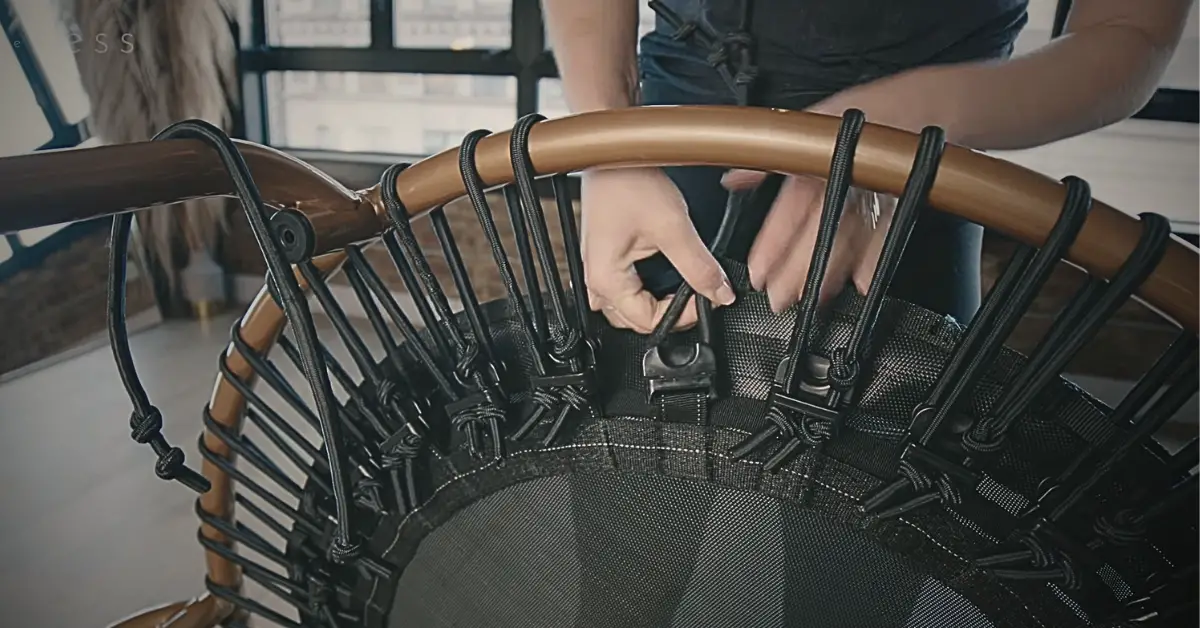
To ensure the safety and longevity of your trampoline, it’s important to check for wear and tear regularly. Inspect the frame, springs, and pads for any signs of damage or deterioration.
Additionally, clean the trampoline surface on a regular basis to help remove dirt and debris that can affect its performance. Properly store the trampoline when not in use to protect it from harsh weather conditions.
If you notice any broken or worn-out springs or pads, replace them promptly. Lastly, always follow the manufacturer’s guidelines for maintenance and usage to ensure a safe and optimal trampoline experience.
Regularly Check for Wear and Tear
It’s important to regularly check for wear and tear on your trampoline to ensure its safety. By checking the durability of your trampoline, you can prevent accidents and injuries while using it. Here are five key things to look out for when examining your trampoline:
- Springs: Inspect each spring carefully for signs of rust or stretching. Replace any damaged springs immediately.
- Mat: Check the mat for holes, tears, or frayed edges. A worn-out mat should be replaced promptly to avoid accidents.
- Frame: Examine the frame for any cracks or bends. If you notice any structural damage, refrain from using the trampoline until it’s repaired.
- Safety net: Ensure that the safety net is intact and securely attached. Any rips or loose connections should be addressed promptly.
- Padding: Inspect the padding around the frame and springs to ensure it’s in good condition. Replace any worn-out or damaged padding as needed.
Regularly checking these aspects of your trampoline will help maintain its safety and ensure a worry-free experience every time you jump on it.
Clean the Trampoline Surface
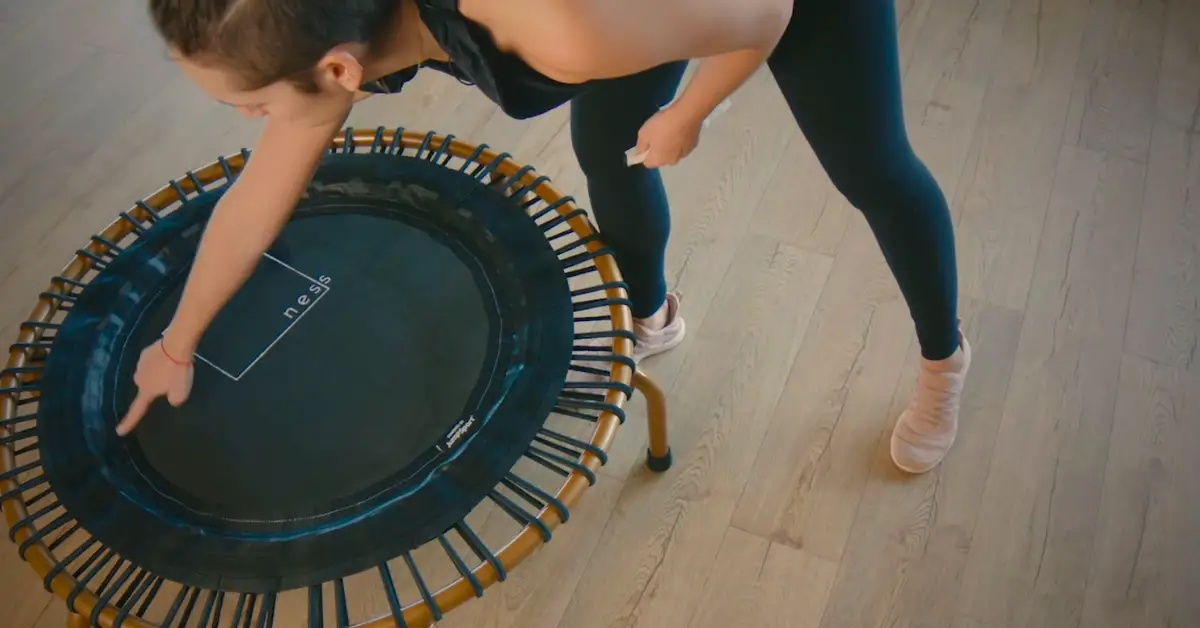
Regularly cleaning the surface of your trampoline ensures a safe and enjoyable jumping experience for everyone.
It’s important to use proper cleaning techniques and the best cleaning products to keep your trampoline in top condition.
Start by removing any debris, such as leaves or dirt, from the surface using a soft brush or broom.
Next, mix a mild detergent with water and gently scrub the mat to remove any stains or grime. Avoid using harsh chemicals that could damage the material.
Rinse thoroughly with clean water and allow it to dry completely before using again.
For stubborn stains, you can try using specialized trampoline cleaners available in the market.
Regularly cleaning your trampoline’s surface can prolong its lifespan and ensure a safe bouncing experience for everyone involved.
Store the Trampoline Properly
When storing your trampoline, follow proper guidelines to maintain its longevity and keep it in excellent condition. Proper trampoline storage is crucial for preserving its structural integrity and preventing damage.
To start, choose a suitable location that’s sheltered from harsh weather conditions such as rain, snow, and excessive sunlight. Ideally, store your trampoline indoors or in a covered area like a garage or shed.
Before disassembling the trampoline, clean it thoroughly to remove any dirt or debris that could cause deterioration over time. Once disassembled, ensure all parts are dry before folding or stacking them neatly.
Additionally, consider covering the frame and mat with a protective cover to shield them from dust and moisture during storage.
By following these trampoline maintenance practices, you can extend the lifespan of your equipment and enjoy safe bouncing for years to come.
Replace Springs and Pads as Needed
To ensure optimal safety and performance, you should promptly replace worn-out springs and pads on your trampoline. Regular maintenance is crucial for a safe and fun workout experience.
Here are some reasons why replacing springs and pads as needed is essential:
- Enhanced Safety: Worn-out springs can lead to uneven bouncing, increasing the risk of accidents. Torn or worn-out pads may expose the metal frame, potentially causing injuries.
- Improved Performance: Fresh springs provide better bounce and responsiveness, allowing you to enjoy a more exhilarating workout.
- Extended Lifespan: By replacing worn-out parts promptly, you can extend the overall lifespan of your trampoline.
- Fun Workout Variations: Upgrading your trampoline with new springs and pads opens up possibilities for exciting workout variations like rebounding exercises or high-intensity interval training.
Remember to regularly inspect your trampoline’s components and replace any damaged or worn-out parts to maintain its safety and maximize your fitness routine.
Follow Manufacturer Guidelines
Ensure you follow the manufacturer’s guidelines for proper maintenance and usage of your trampoline to ensure a safe and enjoyable experience. These guidelines provide essential safety tips that can help prevent accidents and injuries.
Here are some key points to keep in mind:
| Manufacturer Guidelines | Safety Tips |
|---|---|
| Regularly inspect the trampoline frame, springs, and mat for any signs of wear or damage. | Always use a safety net enclosure to prevent falls from the trampoline. |
| Replace any worn or damaged parts immediately with approved replacements from the manufacturer. | Limit trampoline usage to one person at a time to avoid collisions and reduce the risk of injury. |
| Avoid placing the trampoline near trees, fences, or other objects that could pose a hazard if fallen onto. | Never allow somersaults or flips on the trampoline as they can lead to serious head or neck injuries. |
By following these manufacturer guidelines and implementing these safety tips, you can ensure that your trampoline remains in good condition and provides a safe environment for everyone using it.
Fun and Creative Workout Ideas
Engage in various enjoyable and imaginative workout activities to elevate your trampoline exercises at home. Not only will these activities make your workouts more exciting, but they’ll also help you achieve better results.
Add fun dance routines to your trampoline workout sessions to get your heart rate up while having a blast. You can find online tutorials or create your own dance routine by combining different moves and grooving to your favorite tunes.
Incorporating partner exercises is another way to make your trampoline exercises more enjoyable. Grab a friend or family member and try synchronized jumps or bouncing routines together. This adds an element of fun and allows you to challenge each other and push yourselves further.
Consider using props during your trampoline exercises for a creative workout idea. You can incorporate resistance bands, weighted balls, or even small dumbbells into your routine. These props will add an extra challenge and help target specific muscle groups.
Remember, the key is to have fun while staying active on the trampoline. Explore different workout ideas that suit your interests and keep you motivated. Adding variety and creativity to your trampoline exercises can make them more engaging and effective in achieving your fitness goals.
Tips for Exercising Safely with Kids
Exercising with kids can be a fun and healthy way to spend time together, but it’s essential to prioritize safety. Here are some tips for exercising safely with kids:
- Warm-up Together: Before starting any physical activity, engage in a brief warm-up together. This can include light stretching, jumping jacks, or jogging in place to prepare the body for exercise.
- Choose Age-Appropriate Activities: Select exercises and activities that are suitable for your child’s age and physical abilities. Avoid exercises that may be too challenging or risky for their age group.
- Use Proper Gear: Make sure your child wears appropriate footwear and clothing for the activity. Proper shoes with good grip and comfortable clothing can prevent injuries.
- Stay Hydrated: Keep water nearby and encourage your child to drink fluids regularly, especially on hot days or during intense exercises.
- Supervise Closely: Always supervise children during exercise to ensure they are performing activities safely and correctly. Offer guidance and support as needed.
- Create a Safe Exercise Area: If you’re exercising at home, ensure the space is free of obstacles or hazards. Use protective mats around the trampoline or other equipment to minimize the risk of injury.
- Teach Proper Form: Demonstrate and explain how to perform exercises with proper form. Correcting their technique can prevent injuries and improve their effectiveness.
- Start Slowly and Progress Gradually: Begin with low-intensity exercises and gradually increase the intensity and duration over time. Avoid pushing kids too hard, and let them set their pace.
- Listen to Their Bodies: Encourage kids to communicate if they feel any discomfort or pain during exercise. If they experience pain or exhaustion, take a break and rest.
- Include Fun Activities: Make exercise enjoyable by incorporating games, challenges, or playful elements into the routine. This will keep kids engaged and motivated.
- Be Mindful of Weather Conditions: When exercising outdoors, consider weather conditions. Avoid exercising during extreme heat or cold, and provide adequate sun protection.
- Emphasize Teamwork and Support: Encourage teamwork and cooperation during group exercises. Foster a supportive environment where kids feel comfortable trying new activities.
- Be a Role Model: Lead by example and demonstrate a positive attitude towards exercise and physical activity. When kids see you enjoying fitness, they are more likely to follow suit.
- Cool Down and Stretch: End each exercise session with a cool-down period and gentle stretching. This helps reduce muscle soreness and promotes flexibility.
Remember, the goal is to make exercise a fun and enjoyable experience for kids while ensuring their safety. By following these tips, you can create a positive exercise environment and promote a lifelong love for physical activity.
Related Article: 10 Best Mini Trampoline Exercises For a Full-Body Burn
Frequently Asked Questions:
Q.1 What are the potential risks and dangers of trampoline exercises?
To ensure your safety while doing trampoline exercises, it’s important to know the potential risks and dangers. You can enjoy the benefits without unnecessary harm by following proper safety precautions, such as using a safety net and avoiding flips.
Q.2 How often should I replace the trampoline mat?
Replace your trampoline mat every 3-5 years or sooner if you notice signs of wear and tear. Regularly inspect for holes, fraying, or sagging. Proper maintenance ensures a safe and enjoyable trampolining experience.
Q.3 Can trampoline exercises help with weight loss?
Trampoline exercises can benefit weight loss by providing a full-body workout and increasing calorie burn. To maximize weight loss, incorporate high-intensity interval training and combine trampoline exercises with a healthy diet.
Q.4 Are trampoline exercises suitable for people with joint problems?
Trampoline exercises can be suitable for people with joint problems, providing gentle, low-impact workouts on the joints. They can help improve joint health and offer relief from arthritis symptoms.
Q.5 What fun and creative ways to incorporate trampoline exercises into a workout routine?
Incorporate creative trampoline workouts into your routine for a fun and effective way to exercise. Enjoy the benefits of increased cardiovascular fitness, improved balance, and strengthening muscles while having a blast on the trampoline.
Conclusion:
In conclusion, trampoline exercises at home offer many benefits for your physical fitness. You can improve your overall health and well-being by incorporating warm-up exercises, cardiovascular workouts, strength training exercises, core workouts, and stretching exercises into your routine.
Remember to prioritize safety by following the necessary precautions and maintaining your trampoline properly. With some creativity and fun workout ideas, you can enjoy a practical and enjoyable workout experience right in the comfort of your own home.
So why wait? Start bouncing towards a healthier lifestyle today!
After reading this detailed guide on Trampoline Exercises At Home, we trust that you will gain a thorough understanding. If you have any inquiries, please feel free to comment below!

